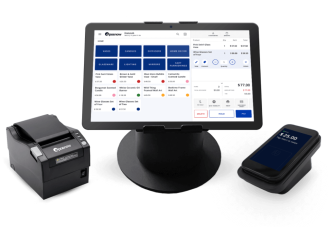Food Waste Management Tactics For Operational Efficiency
Did you know that we waste an insane amount of food each year? According to the nonprofit Feeding America, a massive 92 billion (yup, that's BILLION with a B) pounds of food go to waste every year. That's a whole lot of grub going straight to the trash!
And while all this is happening, millions of hungry people across America are struggling to find their next meal. But guess what? We can totally do something about it! Whether you're running a restaurant, a supermarket, or any food business, we've got some killer food waste management tips to help you save money, boost efficiency, and do some good for the planet.
Ready to make a change? Let's get into it!
The cost of wasted food in restaurants
Let's talk about how much wasted food is really costing you. Spoiler: It's a lot more than you think!
How wasted food has affected food service businesses
Wasted food is a major issue for restaurants and food service businesses. Every time good food ends up in the trash, it’s like tossing money right out the door. In fact, the restaurant industry spends an eye-watering $162 billion every year on costs related to wasted food.
Say you’re a restaurant owner. You buy ingredients with the expectation that they’ll be used to create delicious meals for your customers. But if too much of that food goes to waste, you’re not just losing the cost of the ingredients—you’re also wasting labor, energy, and resources used in cooking and handling the food. It’s like paying twice for the same meal: once to buy the ingredients and again when you throw them away.
This kind of waste also impacts your bottom line in other ways. For one, it drives up the cost of running your kitchen and your expenses. Spoiled or unused food means you’re constantly buying more to replace it, leading to over-ordering and increased spending. On top of that, dealing with excess waste can lead to higher disposal fees and additional labor costs associated with managing and tracking waste.
Managing food waste more effectively can make a huge difference. And, we'll get on to how you can do this with some food waste reduction strategies in a little bit!
The social and environmental impacts on the food industry
Wasted food isn’t just bad for your business, it’s a big problem for our planet too. When food gets tossed out, it doesn’t just disappear. It ends up in landfills, where it breaks down and produces methane. Methane is a powerful greenhouse gas that traps heat in the atmosphere, contributing to climate change. In fact, according to a food and agriculture organization food waste is responsible for about 8% of all global carbon emissions.
But it’s not just the methane that’s the issue. Think about all the resources that went into growing, transporting, and preparing that food. It takes a lot of water, renewable energy, and fuel to get food from the farm to your plate. When food is wasted, all these resources are wasted too. For example, producing a single pound of beef can use more than 1,800 gallons of water (that's enough to fill 34 bathtubs!) Tossing that beef means throwing away all the water used to produce it.
Reducing food waste had a positive impact on the environment. By reducing waste, you’re helping to reduce greenhouse gas emissions like greenhouse gases and conserve precious resources like water and energy. In the end, every little effort to reduce food waste adds up.
7 Strategies to reduce food waste
Okay, you now know what food waste is, and why it's so bad for businesses (and the planet). So, it's time to get practical. Here are some easy, actionable food waste management solutions that you can use to cut down on excess food going to waste in your restaurant or food service business.
Carry out food waste reporting
Our first tip to reduce waste in the food produced at your restaurant is to carry out some food waste reporting. The same way you can work out your food cost percentage, you can also do some food waste reporting, which is all about tracking and documenting all the food that gets thrown away. It’s about knowing exactly what’s going to waste, why it’s happening, and how you can fix it.
To start with food waste reporting, you need a system in place to log every instance of food being discarded. This could be as straightforward as keeping a waste log where staff jot down what’s thrown out and why. For a more detailed approach, categorize the waste into groups—like organic waste, produce, meats, food scraps, or prepared dishes. This helps in identifying patterns and pinpointing problem areas.
Here’s a simple process to get started:
-
Set up a tracking system: Decide how you’ll track waste (we're talking either manual logs, spreadsheets, or a digital system)
-
Train your staff: Make sure everyone on your brilliant team knows how to record waste.
-
Log waste regularly: Record every instance of food waste throughout the day. Include details like the type of food, amount, and reason for food waste disposal.
-
Review the data: Look at your waste logs regularly. Spot any patterns—maybe you’re wasting a lot of a certain ingredient or throwing away food at a specific time.
-
Make changes: Use what you learn to fix problems. Adjust your orders, change portion sizes, or improve how you store food. You can also implement procedures like organics recycling your food items, so that when food loss occurs, you're still not contributing to the greenhouse gas impact.
At this point, you might be thinking, “That sounds like a lot of work!” And it can be, but a hospitality POS system can make this process a whole lot easier. A lot of modern POS systems offer integrated food waste reporting features, allowing you to log and analyze waste with just a few clicks. This means you get real-time insights and can make data-driven decisions to cut down on waste, save money, and streamline operations. So, use your POS system to simplify and enhance your food waste reporting.
Review your supply chain operations
Your supply chain operations refers to the journey your food takes from your suppliers to your kitchen. If you’re wasting a lot of food, it might be time to look at how things are moving along that chain.
To do this, start by checking out where your ingredients come from. Are you ordering too much? Or maybe the deliveries aren’t arriving on time, leading to spoiled goods. Here’s how to give your supply chain a quick once-over:
-
Check your orders: Make sure you’re ordering just the right amount of food. Ordering too much means more waste and too little means you might run out and scramble for more.
-
Assess supplier reliability: Are your suppliers reliable? If they’re late on deliveries or send poor-quality ingredients not good enough for human consumption, it can lead to waste. If they’re not cutting it, you might need to find new ones.
-
Review storage practices: Once the food arrives, how is it stored? Good storage can make a big difference in how long food lasts. Check if your fridge and pantry are organized and set at the right temperatures.
-
Monitor waste from deliveries: Sometimes food waste occurs before the food even hits your kitchen. If you’re getting a lot of damaged or spoiled goods, it’s a sign something’s going wrong.
A well-managed supply chain can dramatically reduce food waste. When things flow smoothly from supplier to kitchen, you waste less and save more.
Optimize menu planning
This is about figuring out what dishes to offer and how to use ingredients efficiently. Good menu planning can help reduce food loss and keep things running smoothly.
Start by looking at your current menu. Are there dishes that don’t sell well? If so, it might be time to tweak or remove them. Focus on items that your customers love and order often. This way, you use ingredients more effectively and reduce waste from unsold food.
Think about ingredient overlap. Try to use the same ingredients across different dishes. For example, if you’re buying a bunch of fresh herbs for one dish, use those same herbs in other menu items. This helps you buy in bulk and cut down on leftover ingredients going to waste.
Portion sizes matter too. If you’re serving portions that are too big, you’re likely to see more leftover food. Adjust portions to better match what your customers want and can eat. You can also offer options, like half portions or smaller sides, so people can choose what works best for them.
Keep an eye on seasonal ingredients when you're working on food production. Using seasonal produce not only supports local farmers but also means fresher ingredients that last longer. It can also be more cost-effective and reduce waste, as seasonal items are often at their peak and less likely to spoil quickly.
Implement advanced ordering systems for better kitchen management
An advanced ordering system can really streamline how you handle orders, both online and in-person, and help keep your kitchen running like a well-oiled machine.
Using tools like Epos Now’s Order & Pay, restaurant management software, and kitchen display systems (KDS) can really help you stay on top of things.
Epos Now’s Order & Pay handles everything - whether customers order online, in-person, or for pickup - all from one place. This means no more juggling different systems like a circus performer. Plus, customers can pay using QR codes, URLs, or even digital wallets like Apple Pay and Google Pay making things smoother for them and helps you avoid those annoying mistakes that lead to wasted food.
Then there's restaurant management software. Think of it as your restaurant’s personal assistant. It keeps track of reservations, inventory, order management, and staff schedules all in one spot. This means you’re less likely to over-order ingredients or mess up your stock, which helps you use up what you have and waste less food.
And don’t forget about kitchen display systems (KDS). These replace those old paper tickets with digital screens in the kitchen. (Bye-bye, paper clutter! Hello, efficiency!) The kitchen staff can see orders clearly and get them right, which cuts down on mistakes and wasted ingredients.
So, using these systems together can seriously boost your game. They make managing orders easier, reduce errors, and help keep your kitchen running smoothly. Less food waste means more happy customers—and more cash in your pocket.
Use a real-time inventory management software
Have you ever run out of an ingredient just when you needed it? Or overstocked, only to see food go bad and end up in the trash? It’s frustrating and costly.
Not knowing exactly what’s in your inventory can lead to big problems. Over ordering means wasted food and money, and running out of ingredients means unhappy customers and missed sales.
This is where real-time inventory management software comes in. Many POS systems have this feature integrated and with this tool, you always know what’s in your stock. No more scrambling for missing ingredients or throwing out spoiled food.
This software helps you spot issues early. If you see certain items are over-ordered or not used enough, you can quickly adjust your buying and menu plans. This helps cut down on waste and keeps everything running smoothly. It also simplifies your ordering process. The software can automate reordering when stock levels get low meaning you won’t run out of essentials or overstock and waste food.
By keeping a close eye on your inventory and usage, you can use ingredients before they go bad. Less guesswork means fresher food and less spoilage.
Engage in food donation programs
Got extra food you can’t use? Don’t throw it away! There are plenty of people who could really use it. That’s where food donation programs come in. They’re a win-win for everyone involved.
Food banks and soup kitchens are always looking for donations. Grocery stores, restaurants, and other food donors can help out by giving their surplus food to these places. It’s a great way to make sure that edible food doesn’t go to waste and ends up feeding hungry people instead.
Donating food is super easy. Just connect with local food banks or charities and see what they need. You can set up a regular donation schedule or just give what you have when you can. They’ll handle the rest, making sure the food gets to those who need it.
Plus, donating food can actually save you money. You might get tax benefits, and you’ll spend less on waste disposal. It’s good for the community and good for your bottom line.
So, next time you have extra food, think about donating it. You’ll be helping out people in need and doing your part to reduce food waste. It’s a simple way to make a big difference.
Set up composting systems
Setting up a composting system is a great way to deal with food waste. It’s good for the environment and can even benefit your business.
Composting turns organic waste into nutrient-rich soil. Instead of sending food scraps to the landfill, where they produce methane (a nasty greenhouse gas), you can compost them and reduce your carbon footprint.
Getting started with composting is easier than you think. First, figure out what kind of composting system works best for you. There are different options, from small compost bins to larger commercial systems. You can compost fruit and vegetable scraps, coffee grounds, eggshells, and more. (Just avoid meat and dairy—they don’t break down well and can attract pests.)
Next, find a good spot for your compost bin or pile. Make sure it’s easy for your kitchen staff to access. Train your team on what can and can’t be composted. It might take a little time to get everyone on board, but once you do, it’ll become second nature.
Not only does composting reduce waste, but it can also save you money on waste disposal fees. Plus, if you have a garden or landscaping around your business, you can use the compost to enrich the soil. It’s a win-win!
So, give composting a try. It’s a simple, eco-friendly way to manage food waste and do your part for the planet. Your garden (and the environment) will thank you!
Discover more about our restaurant POS systems now!
Take your restaurant operations to the next level now.
Importance of efficient food waste control for your business
Efficient food waste control is a big deal for your business. It can improve how smoothly things run, boost your profits, and make your customers love you even more. Here’s why it matters:
Operational efficiency improvement
Managing food waste well means a more organized kitchen. Less waste means less mess and fewer last-minute scrambles. This saves time and reduces stress for your staff, making everything run more smoothly. Imagine not having to search for that one ingredient in a sea of unnecessary leftovers (hallelujah!). Your kitchen staff will thank you, and you’ll see a noticeable improvement in how smoothly things operate.
Maximize profit margins
Wasting less food directly impacts your bottom line. Every bit of food you don’t throw away is money saved. By controlling waste, you reduce food costs and improve your profit margins. Think of it this way: more efficiency means more cash in your pocket. Plus, you can reinvest those savings into other parts of your business. (Fancy new espresso machine, anyone?) The less you waste, the more you make. It’s a simple formula with big results.
Improves brand image and customer satisfaction
Customers care about sustainability in food service. When they see you reducing food loss, it boosts your brand image. They’ll appreciate your eco-friendly efforts and are more likely to support your business. Plus, efficient operations usually mean better service, which keeps customers happy.
FAQ about reducing food waste
- What challenges do businesses face in reducing food waste?
-
Figuring out how much to order, training staff, and dealing with unexpected changes in customer traffic can be tricky. It’s a constant balancing act!
- What is the average food waste percentage in restaurants?
-
On average, restaurants waste about 10% of the food they buy. Waste tracking tools like a POS can help with waste management. You'll be able to monitor food loss and waste and it's one of the most effective ways to manage food waste.
- What is the biggest cause of food waste in restaurants?
-
Over-ordering and improper storage are the biggest culprits of waste in food. That, and those crazy busy nights that mess with planning and waste minimization.
- How do restaurants plan meals for less waste?
-
They use smart inventory tracking, plan menus based on seasonal ingredients, and get creative with leftovers. Plus, they listen to customer favorites!




